Sinterklaas vs Santa – Eight Humorous Differences
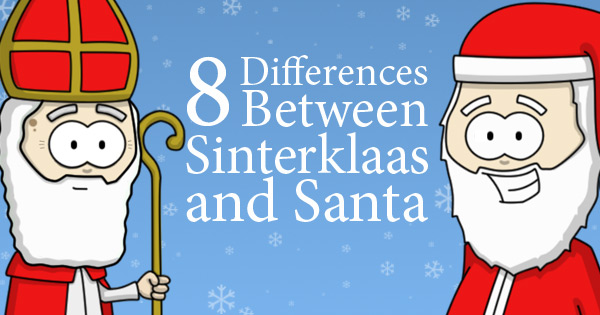
November and December can be a very confusing time of year for expats in The Netherlands, especially for those who have never heard the name Sinterklaas or seen a Zwarte Piet before.
Who is Sinterklaas?
If you were to ask a Dutch Person to describe Sinterklaas they would probably say something along the lines of, “He is a very nice old man who has a long white beard, dresses in red and gives gifts to all the good girls and boys in December.”
Sinterklaas vs Santa
Whatever you do, do not follow this up by asking them how that makes him any different from Santa, not unless you want to seriously damage diplomatic relations between The Netherlands and your own country. They are two very different people. They just happen to work in the same area of business. Here are eight differences that will help you tell them apart.
1) North Pole vs. Spain
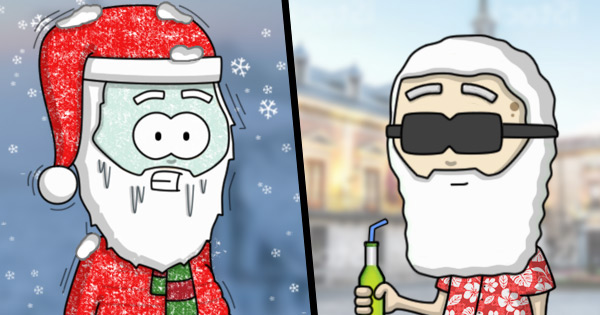
Santa: Lives in freezing cold climate of the North Pole. On Christmas Eve he departs this inhospitable environment, alone, to deliver gifts all around the world without being seen.
Sinterklaas: Lives in Spain for most of the year and (as a result) gets to enjoy more sun and less hypothermia. In the middle of November he temporarily moves his base of operations to the Netherlands to make things easier. His arrival in the country is a huge event known as the Sinterklaas Intocht. A different Dutch city hosts the intocht each year. It is even televised.
2) Fat vs. Thin

Santa: Has not yet found a diet that works for him and as a result tends to be on the overweight side. His weight should not be a surprise. Millions of children all over the world leave cookies, mince pies, milk and/or wine out for him each year.
Sinterklaas: Manages to remain in good shape for his age.
3) Late December vs. Early December
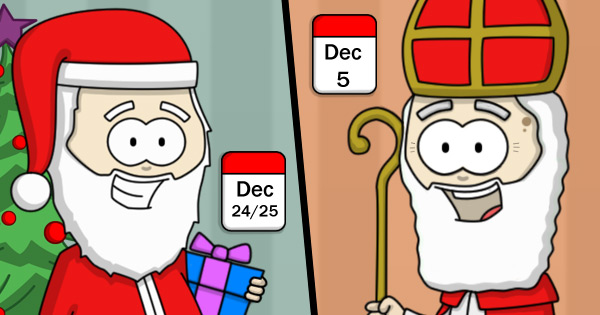
Santa: Delivers gifts under the cover of night on Christmas Eve (December 24th) for children to open the next day on Christmas morning. He has to do this for the whole world in just a few hours.
Sinterklaas: Travels around the Netherlands, delivering gifts, on the 5th of December. The evening this happens is known as Pakjesavond (gift evening). It’s also his birthday. The following day he repeats the process in Belgium and then returns home (to Spain) to enjoy a quiet Christmas.
4) Flying vs. Sailing

Santa: Flies around the world in a sleigh pulled through the night sky by nine magical reindeer.
Sinterklaas: Sails from Spain to The Netherlands in the middle of November on his steamboat, ‘Pakjesboot 12’.
Additional Note: It’s unclear if the preference for flying vs. sailing is because Santa is afraid of sailing or Sinterklaas is afraid of flying. Maybe it has something to do with whatever happened to Pakjesboot 1 to 11.
5) Twelve Reindeer vs. One Horse
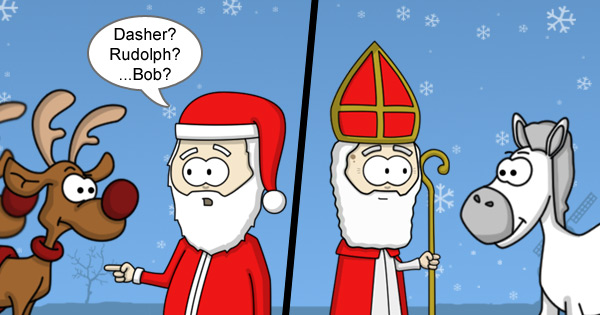
Santa: Has nine overworked magical reindeer who can fly. One of them has a nose that glows.
Sinterklaas: Once he has arrived in the Netherlands he travels around the country on a white horse called Amerigo. As a result, he saves money on animal feed and has to remember less names.
6) List vs. Book
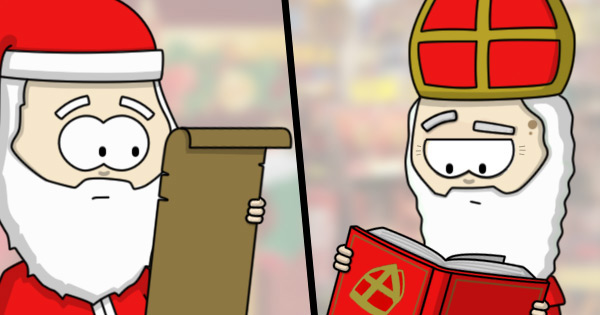
Santa: Keeps the names of the girls and boys who have been naughty or nice on a list (which must be several thousand miles long by now). He used to deal with naughty children by putting a lump of coal in their stocking. However, he has stopped doing that in an attempt to lower his carbon footprint.
Sinterklaas: Keeps everything organized in a book (which never seems to get any bigger despite the growing population). His approach to child behaviour used to be much more zero tolerance. It involved throwing naughty children into a sack, beating them with twigs and dragging them back to Spain. Luckily he realized this was a bit extreme and now takes a much more positive reinforcement approach.
7) Tree vs. Shoe
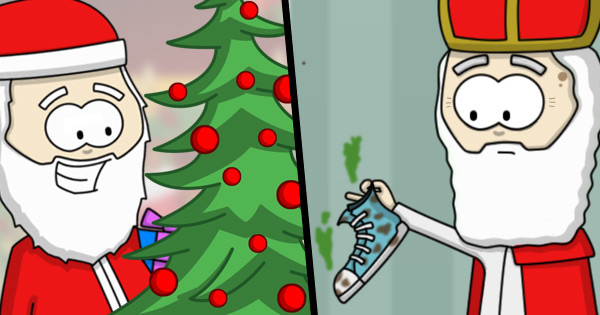
Santa: Places presents for children under the Christmas tree and/or in their stockings on Christmas Eve. This is done secretly and without him being detected.
Sinterklaas: Along with his helpers he already starts delivering gifts before Pakjesavond. They silently leave festive treats, chocolate letters and the occasional small gift known as a schoencadeautje (shoe gift) in children’s shoes. There is often a scattering of Kruidnoten around the scene.
When Pakjesavond arrives they don’t sneak around anymore. They bang on the front door as loudly as they can to announce their arrival. However, when the children open the door Sinterklaas and his helpers are already gone. Only the sack of delivered cadeautjes (gifts) remains.
8) Helpers
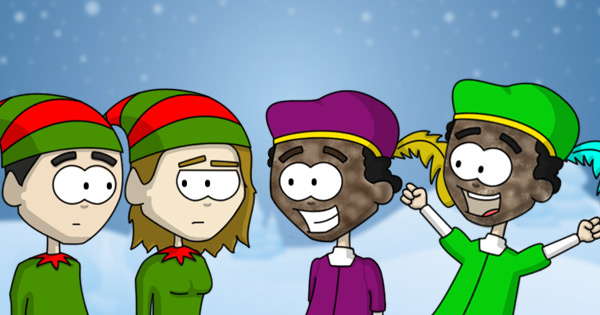
Santa: Helps keep fairytale creature unemployment rates down by employing thousands of elves as his helpers. They run his workshop in the North Pole, help keep him organized and get everything ready for his departure on Christmas Eve. However, they rarely get to leave the North Pole or take part in the deliveries themselves.
Sinterklaas: Has a large group of helpers known as Zwarte Pieten. They are incredibly hyper, a little accident-prone and regularly get their shoe polish mixed up with their face cream. Despite their chaotic nature they get to take on a more active role in the festivities than their elf counter-parts. They crew the steamboat, collect the children’s wish lists, deliver most of the gifts and more.
Conclusion – Sinterklaas vs Santa
Santa: Lives in a freezing cold part of the world. Tries to do all the deliveries, by himself, within just a few hours. Struggles to remain unseen in a growing world of surveillance. Is probably quite stressed.
Sinterklaas: Lives in a warm country. Keeps his home life (Spain) and work-life (the Netherlands/Belgium) separate. Has fun with the public attention. Splits his deliveries over two days and delegates most tasks to his helpers. Has a better life/work balance and is probably less stressed as a result.
Bonus Fact – The Truth About Sinterklaas vs Santa
So there you have it, proof that the two jolly gift-givers are two very different people… or are they?
In 1625 the Dutch travelled to the newly discovered continent of America. Once there they founded the small colonial town of New Amsterdam (which would later become known as New York City). Over time a lot of the traditions of the original Dutch founders were forgotten. However, during the American War of Independence, when the Americans wanted to highlight their non-English past, the Dutch tradition of Sinterklaas was brought back and celebrated once more. Some things were changed of course. It’s even suggested that a miss translation or two led to the Sinterklaas’ new name … Santa Claus.
More Info
Want to read more posts about this Dutch tradition? Check out my post on Why I Love Sinterklaas or read about How to Send a Letter to Sinterklaas.



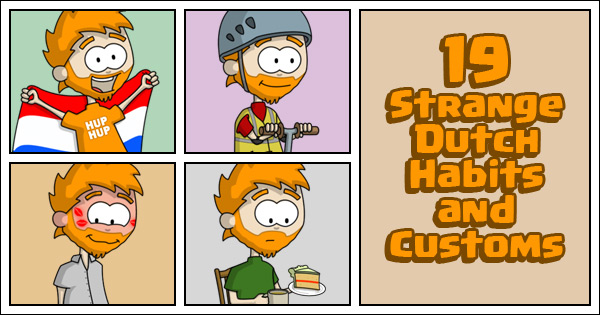

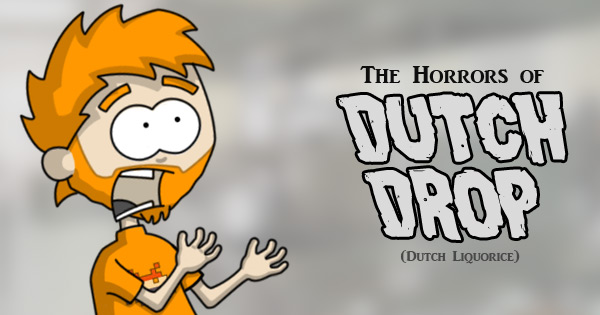


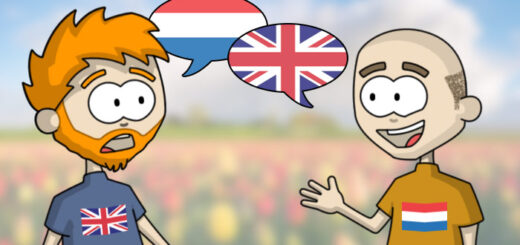


“French Bean – You are right. I correct this mistake and fire my researcher right away. Oh wait… I am my researcher… Darn.”
Stu? YOU’RE FIRED!
In other news, anyone who get’s fired will be deported to Siberia. Good bye.
The nice weather happens to be in the Barcelona/Alicante area, I think.
Now, if I were dragged to France, I would be more tolerant of the beatings!
#8 is the whole reason we moved back to England.
@ Lonneke: thank God it doesn’t!
Very informative indeed!! :D
What has always amazed me is that, being Sinterklaas from Spain, unlike most of his countrymen, he manages to arrive way in advance to distribute all the presents before Christmas! And, how come his Dutch is impeccably perfect? :D
Aledys ver: even expats from Spain can, given a few hundred years, learn the language eventually
I know this is an old post, but Santa is actually based on Sinterklaas :)
A lot of people know this already, but some don’t: The character of Santa was ‘invented’ by Coca Cola (based on Sinterklaas)
You can also see it in the similarity of the name:
Sinterklaas
Santa Claus
I hope your not to mad at me for resurrecting this post from the grave, but I would like to remark that in Flanders, the horse is actually called “Slechtweervandaag”. This name comes from the series “Dag Sinterklaas”, which is part of the collective childhoods of many people.
Sinterklaas horse – “Slechtweervandag” – Bad weather today
Literal translation.
Isn’t the name Amerigo?
It is in The Netherlands. In Flanders it’s Slechtweervandaag.
Some people in the Netherlands do joke that his actual name is not Amerigo but O-zo-snel. Also from a Sinterklaas song. It translates to oh-so-fast. (“Yes he comes in deep dark nights, on his horse, oh so fast.”)
if you giving the liberals their way and get rid of zwarte piete,,i will denounce my dutch heritage!!!! not that that matters,however,zwarte piet kept me in line in my misspend youth..
I’d be surprised if the Dutch ever get ride of him. He might change a little but there will be places in The Netherlands where he won’t change at all.
Most heared comment on the racial discussion in my region.. Try to unemploy all black people in a normal company. That would be something to be punished for.
All zwarte pieten were black. All politically incorrect songs were sung as they were written.
Second sommend i hear a lot is when will there be no more reindeer in front of the sleigh. And what about the elves that work for santaclaus, that is wrong.
Brilliant! This is my first Christmas here so I’m very excited to come back to my first memory when I was a 4 years old girl…Sinterklaas! I’m half spanish half dutch and I’ve been always curious about the fact that Sinterklaas come from (the sunny) Spain in a boat…who knows why? (apart from what wikipedia says…)
Ready to tell my spanish friends and family about dutch traditions and write them on my blog, hehehehehehe.
The link to Spain comes from the time that the Netherlands was still a part of the Spanish empire: the real Sinterklaas came from Turkey. He was a catholic Saint that saved some children.
Sinterklaas is also the patron of the sailors, that’s why he travels by boat…
Of course Sinterklaas saves money…hes’s Dutch!!! Why have the additional cost of elves and reindeer? Surely it’s far more cost effective to live in Spain and enjoy the weather for the rest of the year.
You have a very good point.
for those how can read dutch i woud advise the book of wildgeraas its about the history of sinterklaas santa and all realed things
I never saw the punishment in getting dragged to Spain, but somehow I was never naughty enough for Sinterklaas to take me there… ;)
After living in the us for almost 30 years I can’t wait to see sinterklaas arrive now that we are back in the Netherlands. Best part for me we’re always the poems we wrote with the gifts and the pepernoten. If you have not discovered VanDelft, pepernoten fabriek go and taste the new and improved candy.